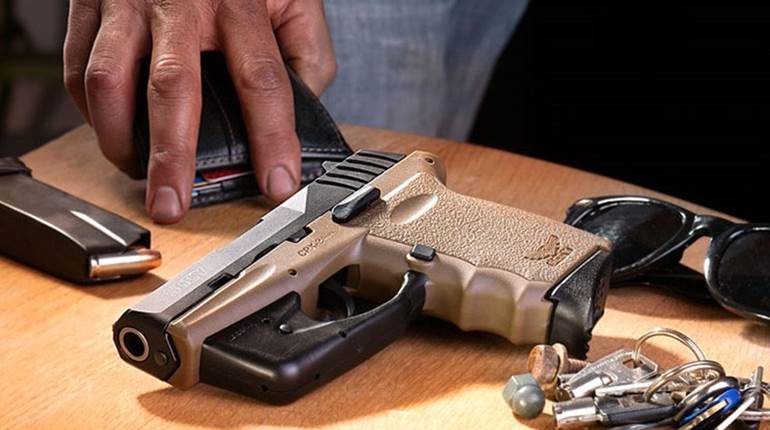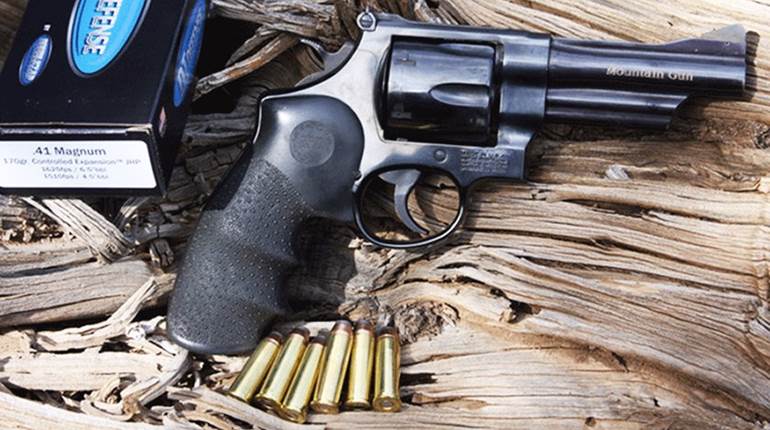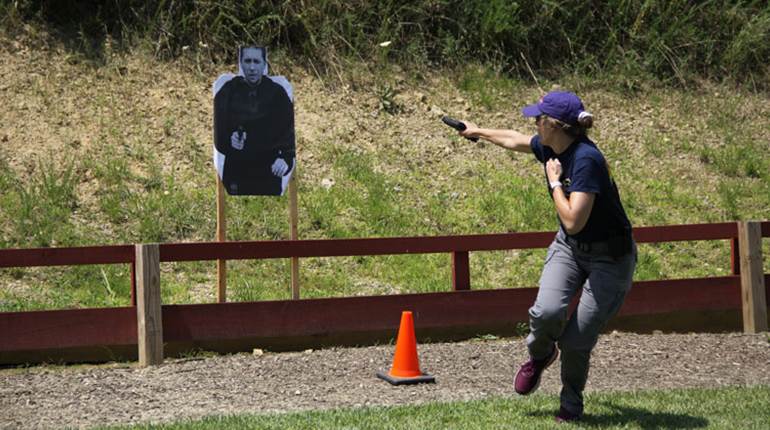
Rob Leatham—Springfield’s Million Dollar Man—works for the Illinois firm as an exhibition shooter, product promoter and all-around expert on things that go bang. He has been doing so for quite a few years. Wearing the Springfield colors and logo, Leatham has traveled the world demonstrating products, teaching their use and winning multiple championships. I’ve been there for a handful of those events and remain impressed with Robbie’s multiple talents, teaching skills and unfailing good humor. Just last week, I was regaling yet another Gunsite Number 250 class with my recollections of Leatham shooting a perfect 3.9-second El Presidente drill (par time for an El Pres is 10 seconds). Clearly, this American handgunner knows his guns and better yet, knows how to use them. It is to Springfield’s credit that Leatham was shown a great deal of deference in the design of the company’s newest line of pistols—the XD(M) 5.25 competition models.
First, let’s get a quick review of the XD in general, then identify why and how the 5.25s are different. Americans first saw the XD under another name and brand—the HS2000 built by the Croatian Metal Co. in a new plant in Croatia. Made to fulfill the country’s police and military service pistol needs, the HS2000 employed a modern design and the latest in gun-manufacturing technology. It had a polymer receiver and metal upper, a simplified manual of arms and a capacious magazine. Early on, a few HS2000s were imported to the United States. Gun-savvy executives at Springfield saw the gun, realized its potential and before you could say “Load and make ready!” asked for some changes and negotiated the import rights. Under the Springfield banner, the HS2000 became the XD (for eXtreme Duty) pistol. It has already gone through several series of upgrades and modifications, including the introduction of the more refined and feature-laden XD(M) pistol. The 5.25s are the most recent.
The XD(M) pistol is a full-size semi-automatic with a double-column magazine. The receiver is polymer with steel inserts. Chambered for the 9 mm Luger, .40 S&W or .45 ACP, the XD(M) is a recoil-operated pistol, with the breech end of the barrel cammed up into register in the broad ejection port. The XD and XD(M)’s operating system is unique in that it uses a grip safety in the backstrap that must be depressed by a proper grasp in order for the gun to function. There is also an articulated safety in the face of the trigger, a feature found on a number of today’s service pistols. This is part of an operating system that Springfield calls the Ultra Safety Assurance system. It is a very safe gun, but one that is quick and easy to use. Safeties all work in the act of grasping the gun, so there is no need for additional manual safety levers. On the XD(M), the Minimal Reset trigger, with a shorter take-up and quicker reset, is standard.
With a grip angle much like the M1911’s, as well as a hand-filling grip, the XD(M) series is ergonomically sound. It is the ergonomics of the gun that first appealed to Leatham. With the increased popularity of so-called “action” shooting games, there is a growing demand for attractively priced, box-stock pistols with respectable accuracy and generous magazine capacities. They also need the other characteristics of premium competition firearms, like precisely adjustable sights that are instantly visible, lots of spare magazines and other accessories such as holsters and pouches. This is where Leatham’s years of experience are so valuable—and why it was Leatham who was so instrumental in putting the 5.25 package together.
Springfield wanted to create a competition-grade pistol at reasonable cost. Literally, it wanted a pistol that a shooter could buy, sight it in and take to the weekend match. It had to be a gun that was good for USPSA, IPSC, IDPA, NRA Action Pistol and possibly other defensive pistol uses. This means that the gun would pass under the bar of rules used in all, not just one, of those shooting sports. And that is part of the reason the gun got its name. Barrel length is important in action shooting, since it results in greater sight radius, as well as slightly improved ammunition performance. Comparing the various rule books, Springfield determined that the longest all-around barrel length that would work is 5.25 inches—which is how the model got its name.
Offered in 9 mm Luger, .40 S&W or .45 ACP, the XD(M) 5.25 is competition-capable right out of the box and is competitive in other ways. First, the pistol is accurate at a level that most polymer guns do not achieve. As we shall see after a range visit, three different 5.25s averaged right at 2 inches (five consecutive, five-shot groups at 25 yards), something that other guns cannot match. It is also competitive in the sense of handling, extra features and price. The 5.25s come in either all-black or bi-tone finish and in three different chamberings—9 mm Luger, .40 S&W and .45 ACP. I had a sample of each for review and noted that the guns seem to be built on the same frame. However, after a phone conversation with Leatham, I discovered that the .45 is slightly larger in the fore-and-aft receiver dimension. That is not surprising, since the .45 ACP round is just a little longer than the 9 mm or .40. Magazine capacities are 19, 16, and 13 for 9 mm, .40 and .45, respectively. Note that three magazines come with each gun.
Handling is excellent with this pistol. It is a hefty, full-size gun with a hand-filling butt section. The mold that creates the receiver produces so-called “pineapple grenade” checkering on the frontstrap, as well as the backstrap. Side panels are extensions of the frontstrap checkering and form a series of ribs that help anchor the gun in the shooter’s hand. All of the polymer ridges are styled like the metal ones machined into the sides of the slide that assist in grasping it to work it back in standard manipulation. Since considerable thought went into the contours of this handgun, I am not surprised to see the lower end of the butt worked into a restrained magazine well. Also, the butt features a removable lower rear corner. Two extra corners come with the gun, in order that the owner can change them to suit the size of his hand and his preferences. By design, the 5.25’s racy appearance is calculated to imply cutting edge functionality. In practice, the gun handles even better than it looks.
The drill is utter simplicity. The shooter inserts a loaded magazine into the butt of an unloaded 5.25, then grasps the slide with an overhand grip, pulls it all the way to the rear and releases it. This action will strip a round from the top position in the magazine and feed it into the chamber as the slide closes. At this point, note that you can’t do this unless the pistol is held in a shooting grip, which compresses the grip safety. You can’t perform any slide manipulation or trigger press, unless the pistol is held in a firm shooting grip. Somewhere around 6 pounds of pressure on the trigger will fire the shot, which will then initiate the traditional semi-automatic pistol slide cycle and places another round in the chamber. There is no manual safety and no need for one. There is only a single lever along the top left side of the receiver—a slide lock to secure the slide to the rear.
Shooters accustomed to the crisp trigger pull of one of Springfield’s M1911 models might struggle with the 5.25 trigger at first. The reset position is well forward and takes some getting used to. With a little practice, it can be learned and with intense and careful attention, it can be mastered. Recall that the gun was at first a service semi-automatic for police and military use. Intended for use under stress, it was never designed for the bullseye range. But today’s action shooting games have their origins in combat shooting, so the trigger works well and safely when speed and accuracy are the order of the day. It’s also appropriate to mention that while the 5.25s are way too big for most people’s concealed carry needs, they would make great home-defense pistols. And, yes, the molded receiver includes an integral laser and/or light rail.
Most of my range shooting centered around the Ransom Rest evaluation. The accuracy of these pistols was very impressive. In limited evaluation shooting (two different loads in each caliber) the three guns fired around the 2-inch mark at 25 yards. There’s also a good chance that a thorough search for more accurate ammunition might be worthwhile. In the hand, I found the guns to be trouble free—zero malfunctions—and pleasant to shoot, even with ammunition as hot as the .45 ACP +P load.
I also have to mention the impressive array of accessories that come with each 5.25. In addition to a high-quality pistol and three magazines, you get an attaché-type hard case, lock, manual and spare front sight element. There’s also a nifty magazine loader, which is almost a necessity when those magazines are new and have stiff springs. Also, there’s a good polymer holster and magazine pouch that will serve as well as the pricey ones. Finally, you get two extra grip inserts that adapt the 5.25 to different hands,
It is a very good deal on a very good pistol. The micrometer adjustable rear sight puts it in a class that cannot be equaled. This is a fine new model from an established American gunmaker.
Importer: Springfield Armory,; (800) 680-6866; www.springfieldarmory.com
Caliber: 9 mm Luger, .40 S&W, .45 ACP
Action Type: recoil-operated, center-fire, semi- automatic pistol
Frame: polymer
Barrel: 5.25"
Rifling: six-groove 1:10" RH twist (9 mm); 1:16" RH twist (.40 S&W), 1:16" RH twist (.45 ACP)
Magazine Capacity: 19 (9 mm), 16 (.40 S&W), 13 (.45 ACP)
Sights: red-dot, fiber-optic front, fully adjustable match rear
Trigger: 6-lb., 8-oz. pull
Overall Length: 8.3"
Width: 1.2"
Height: 5.75"
Weight: 29 ozs. (9 mm Luger & .40 S&W), 32 ozs. (.45 ACP)
Accessories: lockable hard case with two spare magazines, holster, magazine pouch, magazine loader, lock, manual, spare front sight.
Suggested Retail Price: $795 (9 mm blue); $865 (9 mm bi-tone), $795 (.40 S&W blue), $865 (.40 S&W bi-tone); $835 (.45 ACP blue); $896 (.45 ACP bi-tone)






































